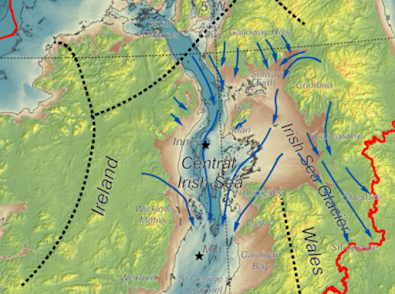If, in due course, some real Altar Stone samples are taken, and if they prove to have "Laurentian" signatures that point to a source in the northern part of the British Isles, where might that source have been located? We can see here that ice flowing into the central Irish Sea channel could have carried erratics from Northern Ireland and the Wicklow Hills, from the western part of the Midland Valley of Scotland, from the Firth of Clyde, from western Galloway and the Southern Uplands, from the Solway Firth and the Lake District and the Isle of Man -- not to mention Ynys Mon and Lleyn. That's a vast area, and within it there are abundant areas of Silurian and ORS rock outcrops, including many areas of grey-green sandstones.
Some of the outcropping ORS areas are shown on the maps in the recent Altar Stone paper.
Here is another map, this time taken from the GCR volume for Northern England, edited by Huddart and Glasser. This map also shows the position of Ailsa Craig. As indicated in an earlier post, Ailsa Craig erratics are scattered on the shores of the Irish Sea, Cardigan Bay and Pembrokeshire.
Even if the ice directions shown in these maps did not apply in earlier glaciations such as the Anglian, I think it is very unlikely that glacial erratics from Orkney can ever have been incorporated into the ice mass of the Irish Sea Ice Stream, for transport southwards.


No comments:
Post a Comment